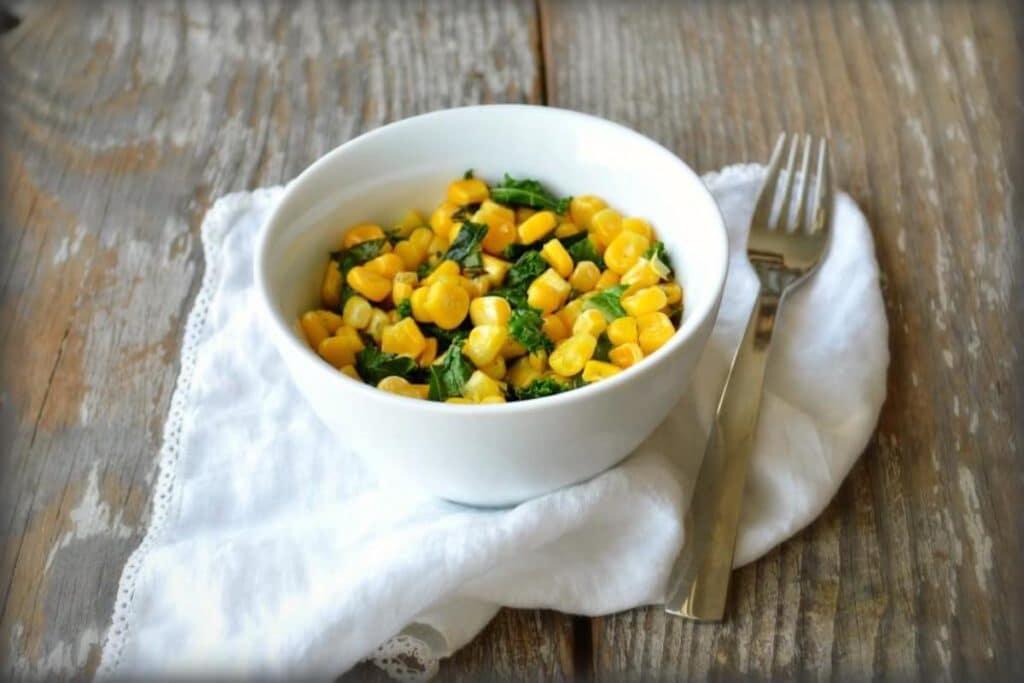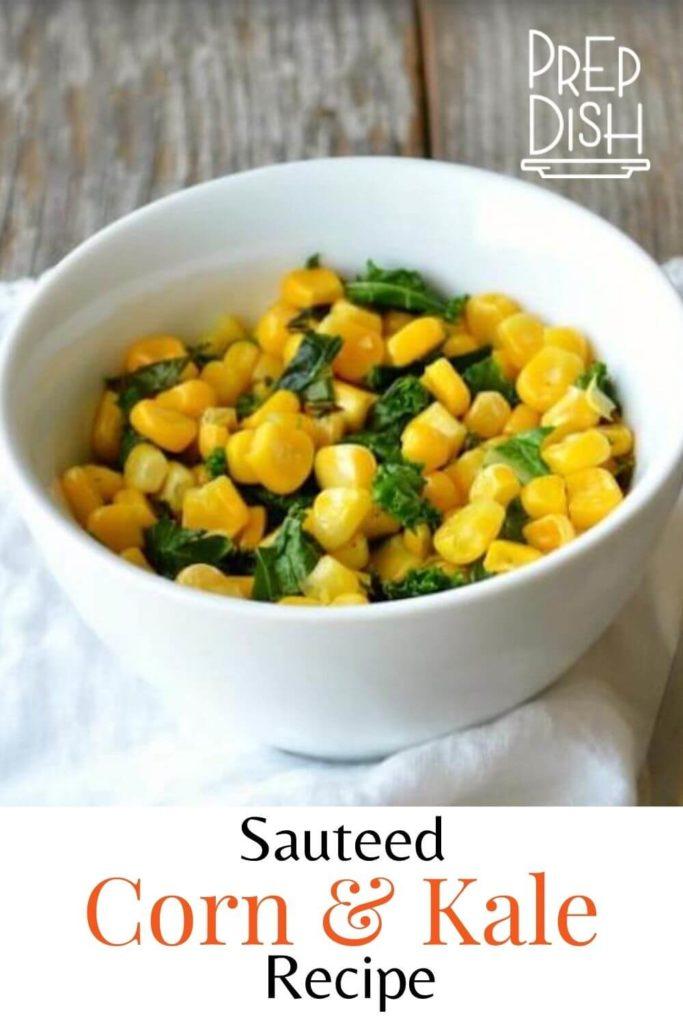
If you’re on the lookout for a frozen kale recipe or a quick and easy gluten-free side dish, you’ve come to the right place! With just five ingredients, this herbed corn and kale dish is the perfect addition to your healthy weeknight dinners.
Simple and Nutritious
This herbed corn and kale recipe was initially crafted for our Pantry/Freezer menu in Spring 2020 and quickly became a hit among Prep Dish subscribers. Its simplicity and versatility make it a go-to option for those times when you’re low on fresh produce or haven’t had a chance to prep anything ahead.
No one enjoys mid-week emergency grocery runs, which is why having a reliable frozen kale recipe is a game-changer. Even when the fridge seems empty, this dish requires just a few staple ingredients. Combining nutrient-packed kale with familiar corn is an excellent way to entice even the pickiest eaters.
The Nutritional Powerhouse
While being a simple side dish, this herbed corn and kale recipe is brimming with essential nutrients. Let’s take a closer look:
- Corn: Despite being mostly carbohydrates, corn ranks low-medium on the glycemic index, meaning it won’t drastically spike your blood sugar. Moreover, corn is a great source of fiber, folate, vitamin B6, and potassium.
- Kale: Kale, the star of this dish, is a nutritional powerhouse, rich in vitamin K, vitamin A, vitamin C, and folate.
- Herbs: The exact blend of herbs may vary, but herbes de Provence generally contains basil, thyme, and rosemary. Basil is a significant source of vitamin K and may also have memory-enhancing, blood pressure-reducing, and mood-boosting properties. Rosemary is packed with antioxidants, while thyme has potential benefits for blood pressure, immunity, and mood improvement.
The Fresh vs. Frozen Debate
Fresh fruits and vegetables are often perceived as the healthiest choice, but frozen produce can be just as nutritious. Frozen kale is picked at peak ripeness and quickly frozen, preserving its nutrients more effectively than produce left on a shelf to gradually degrade.
However, when it comes to frozen kale, there might be a slight decrease in its nutritional value due to blanching before freezing. Blanching and cooking kale can reduce its vitamin C and antioxidant content, but the nutrient loss is minimal. Since vitamin C is abundant in various foods, the overall impact remains insignificant. At the end of the day, consuming leafy greens, whether fresh or frozen, is always a win for your health.
Tips for Tasteful Frozen Kale
While I generally prefer fresh vegetables, frozen produce can be a lifesaver during busy weeks. Here are some tips to make the most of your frozen kale:
- Experiment: Find out which frozen vegetables you and your family enjoy the most. Whether it’s roasted butternut squash, steamed broccoli, or sautéed green beans with lemon and garlic, discovering a few favorites ensures you always have a healthy side dish on hand.
- Thawing and draining: Thaw frozen kale in a colander placed in the sink. This allows excess water to drain as it thaws. Once thawed, make sure to squeeze out any remaining water before using it in your recipes.
Pairing Suggestions
This herbed corn and kale dish is a versatile gluten-free side that combines carbs from corn with the nutritional benefits of kale. Pair it with your favorite protein for a complete and nutritious dinner. You can try it alongside Maple Mustard Pork Tenderloin or a simple salmon recipe.
More Kale Recipes to Explore
If you’re looking for more delicious ways to incorporate kale into your meals, here are some of my favorite recipes:
- Vegetable Bean Soup: This frozen kale recipe from our 2020 pantry menu is a hit. It’s a simple, healthy option that guarantees a homemade meal even when your fridge seems empty.
- 3 Bean, Kale & Ancho Chili: Although this chili recipe calls for fresh kale, you can easily substitute it with frozen kale. It adds a burst of flavor and nutrition to any soup or chili.
- Sweets, Beets & Kale Hash: Start your day with this nutritious breakfast that’s packed with veggies and protein. You’ll be fueled up for even the busiest of days.
- Massaged Kale Salad: If you prefer kale in its raw form, give this citrusy salad recipe a try.
Beyond Recipes: The Versatility of Frozen Kale
Frozen kale is not limited to specific recipes. Here are some additional ideas for incorporating it into your day-to-day cooking:
- Add to soups: Just like spinach, frozen kale is an easy way to boost the nutrition of your soups and stews without much effort.
- Mix into marinara: Sauté frozen kale before adding a jar of marinara sauce. It’s a delightful way to introduce greens into your pasta nights.
- Blend into smoothies: If you don’t have fresh greens on hand, add a handful of frozen kale to your next smoothie. It’s an excellent way to increase the nutritional value, especially for kids who are hesitant to try fresh greens.
- Sauté as a side dish: While fresh veggies might be your preference, keeping a few frozen options on hand is convenient for busy days. Simply sauté some frozen kale with your favorite spices for a quick and healthy side dish.
- Incorporate into frittatas and quesadillas: Add sautéed frozen kale to frittatas, quiches, or quesadillas for an easy and nutritious boost.
Remember, frozen kale is versatile, and you can often use it as a substitute in recipes that call for fresh kale.
FAQ: Frozen Kale Made Easy
How long does cooked frozen kale last? Cooked frozen kale can be refrigerated for approximately 3-4 days. For more tips on food storage, consult my food safety and storage guide.
Can you freeze kale? Absolutely! If you have an excess of kale from your garden or grocery delivery, freezing it is an excellent way to prevent waste. For detailed instructions, follow Beth’s guide on how to freeze kale. Additionally, check out my 10 Freezer Meal Prep Hacks for more freezer meal tips.
Is frozen kale cooked? Yes, like most frozen vegetables, frozen kale is blanched before freezing.
How to Cook Frozen Kale…and Make It Delicious
The secret to cooking frozen kale and making it tasty lies in the thawing process. Rinse the frozen kale under cold running water until it’s completely thawed. Then, make sure to squeeze out any excess moisture before cooking. That’s the key to enjoying flavorful frozen kale!
To discover more recipes, tips, and tricks, sign up for my free weekly newsletter! Plus, you’ll receive a complimentary meal plan as a bonus. And don’t forget to visit Ekilove for more inspiration. Happy cooking!




